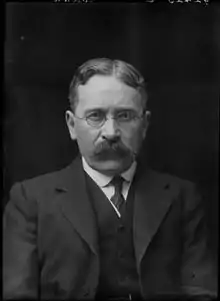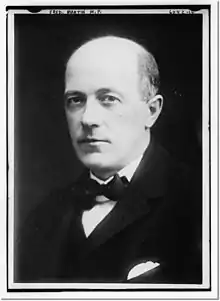Aberdeen and Kincardine East (UK Parliament constituency)
Aberdeen and Kincardine East (or East Aberdeenshire and Kincardineshire) was a county constituency of the House of Commons of the Parliament of the United Kingdom from 1918 to 1950. The constituency elected one Member of Parliament (MP) by the first past the post system of election.
| East Aberdeenshire and Kincardineshire | |
|---|---|
| Former County constituency for the House of Commons | |
| Subdivisions of Scotland | Aberdeenshire, Kincardineshire |
| 1918–1950 | |
| Seats | One |
| Created from | Eastern Aberdeenshire |
| Replaced by | East Aberdeenshire |
As created in 1918, the constituency was largely a replacement for Eastern Aberdeenshire. In 1950, it was replaced by East Aberdeenshire.
Boundaries
Aberdeen and Kincardine East was created by the Representation of the People Act 1918 and first used in the 1918 general election. The constituency was entirely within the county of Aberdeen and one of five constituencies covering the county of Aberdeen, the county of city of Aberdeen and the county of Kincardine (except that the Kincardine burgh of Inverbervie was part of a sixth constituency, Montrose Burghs). Also entirely within the county of Aberdeen, there was Aberdeen and Kincardine Central. Kincardine and West Aberdeen covered the county of Kincardine (minus the burgh of Inverbervie) and part of the county of Aberdeen.
Aberdeen and Kincardine East consisted of "The county districts of Deer and Turriff, inclusive of all burghs situated therein." Therefore, it included the burghs of Fraserburgh, Peterhead, Rosehearty and Turriff.[1]
The same boundaries were used in the 1922 general election, the 1923 general election, the 1924 general election, the 1929 general election, the 1931 general election, the 1935 general election and the 1945 general election.
The House of Commons (Redistribution of Seats) Act 1949 created new boundaries for the 1950 general election. Aberdeen and Kincardine East was merged with part of Aberdeen and Kincardine Central to form East Aberdeenshire, which was one of four constituencies covering the county of Aberdeen and the county of city of Aberdeen. East Aberdeenshire and West Aberdeenshire were entirely within the county of Aberdeen, and Aberdeen North and Aberdeen South were entirely within the county of city of Aberdeen.[1]
Members of Parliament
| Election | Member | Party | |
|---|---|---|---|
| 1918 | Sir William Henry Cowan | Coalition Liberal | |
| 1922 | Frederick Martin | Liberal | |
| 1924 | Robert Boothby | Unionist | |
| 1950 | constituency abolished | ||
Election results
Elections in the 1910s

| Party | Candidate | Votes | % | ±% | |
|---|---|---|---|---|---|
| C | National Liberal | Sir William Henry Cowan | 4,430 | 50.5 | |
| Independent Liberal | Falconer Lewis Wallace | 4,343 | 49.5 | ||
| Majority | 87 | 1.0 | |||
| Turnout | 8,773 | ||||
| National Liberal win (new seat) | |||||
| C indicates candidate endorsed by the coalition government. | |||||
Elections in the 1920s

| Party | Candidate | Votes | % | ±% | |
|---|---|---|---|---|---|
| Liberal | Frederick Martin | 8,018 | 60.5 | +10.0 | |
| National Liberal | Sir William Henry Cowan | 5,227 | 39.5 | New | |
| Majority | 2,791 | 21.0 | +20.0 | ||
| Turnout | 13,245 | 45.5 | |||
| Liberal gain from National Liberal | Swing | N/A | |||
| Party | Candidate | Votes | % | ±% | |
|---|---|---|---|---|---|
| Liberal | Frederick Martin | 8,793 | 55.9 | −4.6 | |
| Unionist | Falconer Lewis Wallace | 6,949 | 44.1 | New | |
| Majority | 1,844 | 11.8 | −9.2 | ||
| Turnout | 15,742 | 57.6 | +12.1 | ||
| Liberal hold | Swing | N/A | |||
| Party | Candidate | Votes | % | ±% | |
|---|---|---|---|---|---|
| Unionist | Robert John Graham Boothby | 7,363 | 46.2 | +2.1 | |
| Liberal | Frederick Martin | 4,680 | 29.4 | −26.5 | |
| Labour | William Sloan Cormack | 3,899 | 24.4 | New | |
| Majority | 2,683 | 16.8 | N/A | ||
| Turnout | 15,942 | 59.0 | +1.4 | ||
| Unionist gain from Liberal | Swing | +14.3 | |||
| Party | Candidate | Votes | % | ±% | |
|---|---|---|---|---|---|
| Unionist | Robert John Graham Boothby | 13,354 | 56.9 | +10.7 | |
| Labour | J.E. Hamilton | 10,110 | 43.1 | +18.7 | |
| Majority | 3,244 | 13.8 | −3.0 | ||
| Turnout | 23,464 | ||||
| Unionist hold | Swing | −4.0 | |||
Elections in the 1930s
| Party | Candidate | Votes | % | ±% | |
|---|---|---|---|---|---|
| Unionist | Robert John Graham Boothby | 16,396 | 72.2 | +15.3 | |
| Labour | Frederick Martin | 6,299 | 27.8 | −15.3 | |
| Majority | 10,097 | 44.4 | +30.6 | ||
| Turnout | 22,695 | 80.5 | |||
| Unionist hold | Swing | ||||
| Party | Candidate | Votes | % | ±% | |
|---|---|---|---|---|---|
| Unionist | Robert John Graham Boothby | 12,748 | 57.0 | −15.2 | |
| Labour | Frederick Martin | 9,627 | 43.0 | +15.2 | |
| Majority | 3,121 | 14.0 | −30.4 | ||
| Turnout | 22,375 | 62.4 | −18.1 | ||
| Unionist hold | Swing | ||||
Elections in the 1940s
| Party | Candidate | Votes | % | ±% | |
|---|---|---|---|---|---|
| Unionist | Robert John Graham Boothby | 13,290 | 54.9 | −2.1 | |
| Labour | John R. Allen | 10,918 | 45.1 | +2.1 | |
| Majority | 2,372 | 9.8 | −4.2 | ||
| Turnout | 24,208 | 66.0 | +3.6 | ||
| Unionist hold | Swing | ||||
References
- Boundaries of Parliamentary Constituencies 1885-1972 (ISBN 0-900178-09-4), F. W. S. Craig 1972
- Whitaker's Almanack, 1920
- The Times, 17 November 1922
- The Times, 8 December 1923
- Oliver & Boyd's Edinburgh Almanac, 1927
- The Times, 1 June 1929
- "UK General Election results October 1931". Political Science Resources. Archived from the original on 26 March 2013.
- "UK General Election results November 1935". Political Science Resources. Archived from the original on 11 August 2011.
- UK General Election results: July 1945 [Archive]